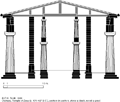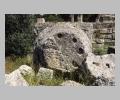| Context: | Olympia |
| Type: | Temple |
| Summary: | Peripteral temple; in the Sanctuary of Zeus, north of the Bouleuterion. |
| Date: | ca. 470 BC - ca. 456 BC |
| Dimensions: | Stylobate: 27.68 m x 64.12 m; external front columns: 5.23 m (4.79 m at corners), axial spacing external side columns 5.22 m (4.75 m at corners); external front column lower diameter: 2.25 m; external side column lower diameter: 2.21 m; height external columns: 10.43 m. |
| Region: | Elis |
| Period: | Early Classical |
| Architect: | Libon |
Architect Evidence:
Literary attestation (
Plan:
Doric peripteral temple, 6 x 13 columns on a crepidoma of 3 unequal steps. An east opening cella, with pronaos and opisthodomos both distyle in antis. Two rows, each of 7 Doric columns with superimposed Doric columns, divided the cella into 3 aisles. The statue on its enormous base was separated from public access by a barrier which ran between the columns of the side aisles and across the cella at the 2nd column and behind the statue base. The temple was approached by a ramp on the east.
History:
Pausanias wrote that the Temple of Zeus was designed by Libon of Elis (
Other Bibliography:
See Also:





